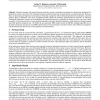Free Online Productivity Tools
i2Speak
i2Symbol
i2OCR
iTex2Img
iWeb2Print
iWeb2Shot
i2Type
iPdf2Split
iPdf2Merge
i2Bopomofo
i2Arabic
i2Style
i2Image
i2PDF
iLatex2Rtf
Sci2ools
117
Voted
NIPS
2008
2008
Non-stationary dynamic Bayesian networks
Abstract: Structure learning of dynamic Bayesian networks provide a principled mechanism for identifying conditional dependencies in time-series data. This learning procedure assumes that the data are generated by a stationary process. However, there are interesting and important circumstances where that assumption will not hold and potential non-stationarity cannot be ignored. Here we introduce a new class of graphical models called non-stationary dynamic Bayesian networks, in which the conditional dependence structure of the underlying data-generation process is permitted to change or evolve over time. Some examples of evolving networks are transcriptional regulatory networks during development, neural pathways during learning, and traffic patterns during the day. We define the non-stationary DBN model, present an MCMC sampling algorithm for efficiently learning the structure of an nsDBN and the times of non-stationarities (transition times) under different assumptions, and demonstra...
Conditional Dependence Structure | Dynamic Bayesian Networks | Information Technology | NIPS 2008 | Time-series Data |
Related Content
| Added | 29 Oct 2010 |
| Updated | 29 Oct 2010 |
| Type | Conference |
| Year | 2008 |
| Where | NIPS |
| Authors | Joshua W. Robinson, Alexander J. Hartemink |
Comments (0)

